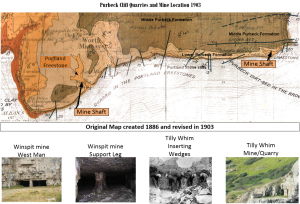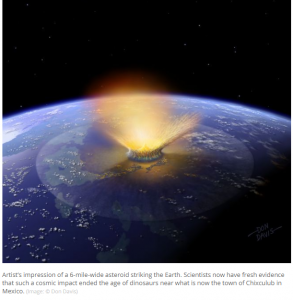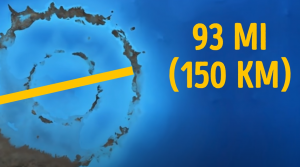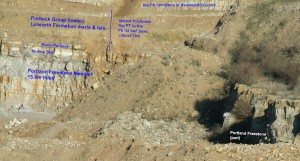Purbeck Sedimentary Rock Formations
The Chicxulub Asteroid
When an asteroid collided with Earth, its impact triggered shockwaves, massive tsunamis and sent a large cloud of hot rock and dust into the atmosphere. As the super-heated debris fell back to Earth, they started forest fires, increased temperatures and wiped out the dinosaurs.
Isle of Purbeck Limestone History
The United Nations Educational, Scientific and Cultural and Organization (UNESCO) granted the coastline World Heritage status. The internationally protected site is now called the “Jurassic Coast”. A more appropriate name for the region would be the Mesozoic coast, but Jurassic has a popular culture association due to the “Jurassic” Park movies, where fictional dinosaurs have been reintroduced into the present by scientists.
This Mesozoic includes three well known periods called the Triassic, Jurassic, and Cretaceous periods and is an interval of geological time from about 252 to 65.5 million years ago, it is also called the Age of Reptiles. A mass-extinction of the Dinosaurs marked the end of the Mesozoic Era.
Leger A. 2006 from the University of Colorado, USA states:
“…..The Purbeck limestone spans from the lower Cretaceous 140–125 million years ago down to the upper Jurassic 150–145 million years ago. The Purbeck stone is a large grained limestone that originated in soft lime muds, shells and other fragments of organisms living in the water. Below the Purbeck limestone lies the Portland limestone that consists of smaller grains of calcite clasts.
The Portland limestone, commonly called “free stone”, is a high quality working stone for building. However, in the towns and villages of Dorset both the limestones are found.
The more important characteristic of the limestone is their strength against erosion. Despite their differences the Purbeck and the Portland limestones share this quality. Compared to surrounding layers these limestones are very resistant and will often form ridges 14
Dr Ian West, a retired geologist from Southampton University states that:
…Durlston Bay, Swanage is the type-section of the Purbeck Formation and the geology has been much studied since it was first described by Thomas Webster in 1816. This classic Purbeck section of lagoonal and lacustrine limestones alternating with shales and marls is the thickest exposed on the coast. Shelly limestones, the Purbeck Stone and Purbeck Marble, have long been quarried. Remains of dinosaurs, mammals, turtles, pterosaurs, crocodiles, fish, isopods and insects have been found here 12 .
The Cretaceous Period, 145.5 million years ago to the Cretaceous-Paleogene (K-Pg) extinction event dated at 65.5 million years ago, nearly all large vertebrates and many tropical invertebrates, no spine, became extinct in what was clearly a geological, climatic and biological event with worldwide consequences. Geologists call it the K-Pg extinction event because it marks the boundary between the Cretaceous and Paleogene periods. The “K” is from the German word for Cretaceous, Kreide
In 1979, a geologist who was studying rock layers between the Cretaceous and Paleogene periods spotted a thin layer of grey clay separating the two eras. Other scientists found this grey layer all over the world, and tests showed that it contained high concentrations of iridium, an element that is rare on Earth, but common in most meteorite
Also within this layer are indications of “shocked quartz” and tiny glass-like globes called tektites that form when rock is suddenly vaporized then immediately cooled, the effect of an extraterrestrial object striking the Earth with great force.
The Chicxulub (CHEEK-sheh-loob) crater in the Yucatan, Mexico, dates precisely to this time. The crater site is more than 110 miles (180 kilometers) in diameter and chemical analysis shows that the sedimentary rock of the area was melted and mixed together by temperatures consistent with the blast impact of an asteroid about six miles (10 km) across striking the Earth at this point 15 .
Chicxulub Asteroid
66 million years ago this asteroid collided with Earth, its impact triggered shockwaves, massive tsunamis and sent a large cloud of hot rock and dust into the atmosphere. As the super-heated debris fell back to Earth, they started forest fires and increased temperatures. This rain of hot dust raised global temperatures for hours after the impact and cooked alive animals that were too large to seek shelter. Small animals that could shelter underground, underwater, or perhaps in caves or large tree trunks, may have been able to survive this initial heat blast.
Tiny fragments likely stayed in the atmosphere, possibly blocking part of the sun’s ray for months or years. For example two months after impact any animal bigger than a crocodile would have been wiped out. Acid rain would have fallen due to the billions of tons of carbon dioxide, methane and carbon monoxide created in the atmosphere, when layers of limestone were vaporised in the impact crater. With less sunlight, plants and the animals dependent on them would have died 15.
Stone on the South of the Isle of Purbeck
The cliff quarries were very productive and used in the construction of Ramsgate Quay after an act of Parliament gave approval for construction of a new harbour, following the Great Storm in 1749, the quarries and mines supplied 15,000 tons of stone. It took 52 sailing ships two years four months to complete the shipment.
The cliffs are solid stone, unlike the Purbeck beds where blocks are separated by loose clay, the Portland stone beds are joined by a 60 centimetre capping stone, known as under-picking cap, separating the seam from the upper layers.
To separate the 20 ton blocks, the capping stone had to be carefully blasted away with gun powder to ensure the ceiling and payload are not damaged. It was separated horizontally and vertically from its neighbours using wedges, known as Gads. This is a highly skilled task that required the workmen to create a hole, with a hammer and punch, half the length of the wedge and a slightly larger diameter, this could take up to two days to complete.
The Portland stone weighs 12 cubic feet/ton 25% lighter than Purbeck stone at 8 cubic feet/ton.
Limestones of the Portland Group are quarried in south Dorset on the Isle of Portland and the Isle of Purbeck. The group is divided into a lower Portland Sand Formation and an upper Portland Stone Formation. The white, ooidal limestone most commonly used in many cities including London, Dublin and Cardiff. In the 14th Century, the stone was exported to Exeter for the Cathedral and in the 17th Century to London for St Paul’s Cathedral. Ooidal limestone is composed mainly of spherical grains (‘ooids’, from the Greek word for egg)
On the Isle of Purbeck, similar though more thinly bedded ooidal limestones are worked as freestone, but are commonly described as Purbeck-Portland Stone, which is a very much harder stone suitable for naval fortification and harbour construction as opposed to the softer more decorative structure of Portland Stone.
The eastern course of the Portland bed from Portland Bill to Durlston head is: at the Bill it runs under the seabed for 25 Kilometre, rises steeply 70 metres to the surface at St Aldhelms Head, at Winspit the seam is approximately 30 metres above the sea, it then slopes gently downwards and appears in the lower structure of Durlston Head as viewed from the sea 16



